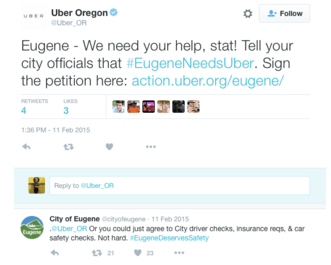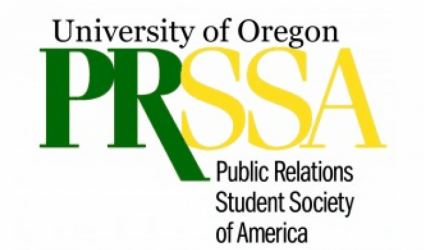By Lily Gordon
The road to thriving company and consumer relationships with a reputable public image can often be bumpy. Largely in part to its relatively new, and disputed, business model, ride-sharing app, Uber has been a star on the Turbulent Public Relations Speedway. While in the driver’s seat, the Uber PR team has navigated controversies ranging from sexual assault charges to sabotaging competitors like rival ride-sharing app, Lyft and traditional taxi services. Uber is available in over 50 countries and 300 cities worldwide and recently has been made unavailable in Eugene, Ore.
Eugene has had a large number of individuals make public appeals in favor of Uber, but other cities have experienced the opposite, like the January 2015 Portland protest pictured above, calling for the ride-sharing app to adhere to city transit laws. (Photo by Aaron Parecki, CC BY 2.0)
History of Eugene Uber
University of Oregon students as well as community members enjoyed the convenience of Uber from summer 2014 until the ride-sharing app had to halt Eugene operations in April 2015. The Eugene City Council met with Uber representatives to negotiate terms under which the company could legally operate in the city. The council eventually released a proposal outlining the requirements Uber would need to meet before continuing to service the Eugene area. It has been 1o months since operations halted, and Uber has yet to make any public moves toward adopting new policies in order to relaunch legally in Eugene.
PR Victory Laps
Über in German means “above” or “over,” and Uber definitely went above and beyond in several aspects of its Eugene Uber campaign, specifically in encouraging civic participation and releasing strategic statements.

Whether the petition to “Support Uber Eugene!” would have been as successful as it has been is questionable had Uber itself not initiated and promoted it. Even earlier this week on the University of Oregon campus, individuals were imploring passersby to sign the petition. Public protests and petitions have in the past been used against the app, but in the instance of Eugene Uber, the power of the people is undeniably being channeled in Uber’s favor. The company seems to have learned from past fallouts and was proactive enough to give a voice to the “correct” side in the debate.

The fact Uber already had a positive reputation in the Eugene community and strong relationships made the “Support Uber Eugene!” campaign more feasible. During the company’s seven-month stint in the area, it partnered with University of Oregon Greek life by supporting fundraisers for the Oregon Make A Wish Foundation.

The app’s victory lap in the campaign to relaunch in Eugene has been fueled by, as simple as it sounds, tactful statements. In other legal controversies Uber has cited itself as a “technology company” rather than a “ride-sharing business.” Uber claims it is solely responsible for the app-based aspects of the service, but many city governments have rejected this argument.
PR Fender Benders
Despite the successes of Uber’s PR in Eugene, there have been a few missteps during the campaign to relaunch Eugene operations. Uber has appealed to the city council via petitions and letter to no avail. At this point, it seems the company’s resources would be better used by simply abiding by the regulations put forth.

Unfortunately for those in the Eugene area hoping to get an Uber ride home after graduation parties in June, the prospects look fairly bleak. While the company has gone above and beyond by encouraging civic participation, building a positive local reputation, and releasing strong statements, the Eugene City Council is unbudging. Sometimes even the best PR cannot combat legal requirements. But until Uber crosses that finish line into Track Town, it will be interesting to keep an eye on the company’s progress on the PR Speedway.







